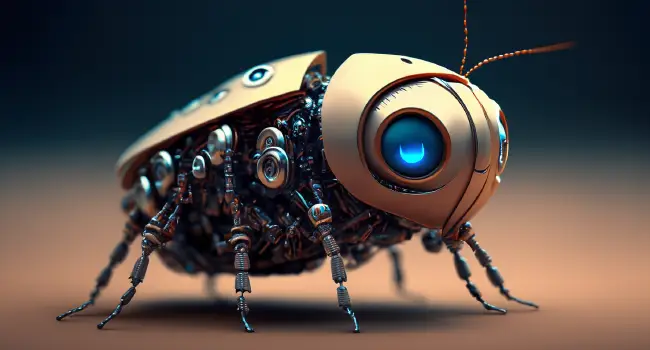Robotic Insects

Robot insects, also known as insect robots or insectoids, are machines designed to mimic the physical appearance and movements of real insects. These robots have been developed for a wide range of applications, including military surveillance, search and rescue operations, and agricultural pollination.
One of the most notable features of robot insects is their size. Because they are typically smaller than other types of robots, they can navigate through tight spaces and move with greater agility than their larger counterparts. Additionally, many insect robots are designed to mimic the appearance of real insects, with wings that flap and legs that move in a lifelike manner. This allows them to blend in with natural environments and avoid detection.
One application for robot insects is in military surveillance. These machines can be equipped with cameras and other sensors, allowing them to gather intelligence in areas that are difficult for humans to access. For example, they can fly into enemy territory to gather information or monitor border crossings without being detected.
Another potential use for insect robots is in search and rescue operations. These machines can be equipped with thermal imaging sensors and other equipment that can help locate survivors in disaster areas. Because they are small and agile, they can also navigate through rubble and other obstacles to reach people who may be trapped.
In agriculture, robot insects have the potential to revolutionize the way crops are pollinated. Honeybees, which are the primary pollinators for many crops, are facing serious threats from disease, habitat loss, and other factors. Robot insects could be programmed to pollinate crops in a similar manner to bees, potentially reducing the dependence on these vulnerable insects.
Despite their potential benefits, there are also concerns about the use of robot insects. Some experts worry that these machines could be used for nefarious purposes, such as spying on individuals or even carrying out attacks. Others raise concerns about the impact of these machines on natural ecosystems, as they could disrupt the behaviors of real insects and potentially spread disease.
Overall, robot insects represent an exciting development in the field of robotics. With their small size and lifelike movements, they have the potential to perform a wide range of tasks that would be difficult or impossible for other types of machines. As researchers continue to refine these robots and explore new applications for them, it will be important to carefully consider the potential risks and benefits of this emerging technology.
Robotic Insect Articles and Web Sites
-
I search the internet daily for new articles from around the world that interest me or I think will interest you. My hope is that it saves you time or helps students with their assignments. Listed by most recent first. Hit NEXT button for more articles
-
MIT’s Latest Bug Robot Is a Super Flyer. It Could One Day Help Bees Pollinate Crops. from Singularity Hub
-
Festo BionicBee video
-
Could We Replace Ingenuity With a Swarm of Robotic Bees? from Universe Today
-
Scientists create tiny flying robot powered by wind and light from BBC
-
Big robot bugs reveal force-sensing secrets of insect locomotion from EurekAlert
-
Click beetle-inspired robots jump using elastic energy from EurekAlert
-
Robotic lightning bugs video
-
Giving bug-like, flying robots a boost MIT video
-
SYFY Wire posted 3D printed ant robots work together to solve problems
-
Insect-like robots video
-
These beetle bots keep flying, even after crashing into poles video
-
A flapping wing MAV (Micro Air Vehicle) video
-
Bug Life: These 5 Robots Were Inspired by Insects - Interesting Engineering
-
The first wireless flying robotic insect takes off - Youtube
-
New RoboBee flies, dives, swims, and explodes out the of water - Harvard - 10/17
-
Tiny flying robot bees are being built to pollinate crops - Youtube (1:20) - 07/16
-
JumpRoACH : Jumping-Crawling Robot - ICRA 2016 - SNU BioRobotics Lab on Youtube - 05/16
-
Using static electricity, RoboBees can land and stick to surfaces - Harvard - 05/16
-
Locust-inspired robot can jump 11 feet high (w/ video) - Tech Xplore - 12/15
-
Dive of the RoboBee: First insect-size robot capable of flying and swimming - Phys.Org - 10/15
-
Robotic insect mimics nature's extreme moves - Phys.Org - 07/15
-
Insect-inspired flying robot handles collisions, goes where other robots can't - Robohub - 10/13
-
Flying Friends or Privacy Pests? - FFA Article - 05/09
-
Tiny robot replicates grasshopper's long leaps - CBC News - 05/08
-
Researchers Create Robot Driven by Moth's Brain - Phys.Org - 11/07
-
Giant cockroach robot - Gizmodo - 06/07
-
Cockroach-Like Robot - Phys.Org - 09/04
-
Micromechanical Flying Insect - UC Berkeley
-
Harvard Microrobotics Lab - Harvard
-
Harvard Microrobotic Fly - YouTube Video
-
Cockroach Controlled Mobile Robot - Concept Lab
-
Cricket Lab - University of Edinburgh
-
Robot Cricket - Cornel
-
LEGO Robot Ant - Richard P. Taylor
-
MIT Robot Ants - James McLurkin
-
Ornithopters - Retail site

